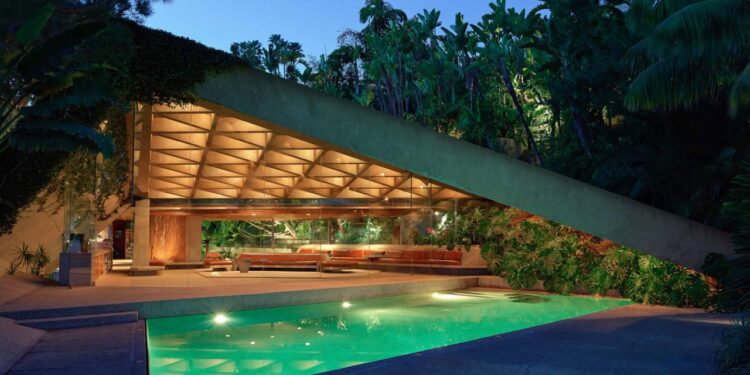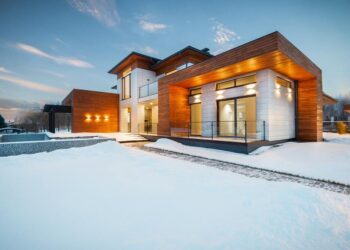With Lautner House: A Masterpiece of Modern Architecture at the forefront, this paragraph opens a window to an amazing start and intrigue, inviting readers to embark on a storytelling filled with unexpected twists and insights.
Delve into the rich history and significance of the iconic Lautner House, exploring its unique features and the influence of John Lautner on its design.
Overview of Lautner House

The Lautner House, designed by renowned architect John Lautner, stands as a masterpiece of modern architecture known for its innovative design and structural ingenuity. Completed in 1949, this iconic residence showcases Lautner's visionary approach to blending nature with architecture.
Key Features of the Lautner House
- Organic Architecture: The house seamlessly integrates with its natural surroundings, with sweeping curves and expansive windows that offer breathtaking views of the landscape.
- Cantilevered Roof: Lautner's daring use of a cantilevered concrete roof creates a sense of weightlessness and openness, defying traditional architectural norms.
- Concrete Construction: The house's use of concrete as the primary building material not only provides durability but also contributes to its unique aesthetic appeal.
- Indoor-Outdoor Living: Lautner's design blurs the boundaries between indoor and outdoor spaces, allowing residents to experience a harmonious connection with nature.
Influence of John Lautner
John Lautner's innovative design principles, characterized by bold forms and a deep appreciation for nature, are evident in every aspect of the Lautner House. His commitment to pushing the boundaries of architecture and his emphasis on creating spaces that enhance the human experience have solidified his legacy as a true visionary in the field of modern architecture.
Architectural Design of Lautner House
The architectural design of Lautner House, crafted by the renowned architect John Lautner, showcases a fusion of innovative elements that set it apart as a masterpiece of modern architecture. Lautner's unique approach to design and his incorporation of organic architecture principles have left a lasting impact on the world of architectural innovation.
Unique Architectural Elements
John Lautner's design for the Lautner House features a striking use of geometric shapes, dramatic angles, and expansive glass walls. The integration of concrete, steel, and wood elements creates a harmonious balance between strength and elegance. The inclusion of a cantilevered roof adds a sense of weightlessness and modernity to the overall structure, defying traditional architectural norms.
Organic Architecture Principles
In designing the Lautner House, John Lautner embraced organic architecture principles, which aim to harmonize human habitation with the natural environment. The house seamlessly blends into its surroundings, with its open floor plan and large windows inviting nature to become an integral part of the living space.
The use of natural materials and the incorporation of sustainable design elements further emphasize Lautner's commitment to creating a home that coexists harmoniously with its ecosystem.
Integration of Indoor and Outdoor Spaces
One of the most striking features of the Lautner House is its seamless integration of indoor and outdoor spaces. The expansive glass walls and open floor plan blur the boundaries between the interior and exterior, allowing residents to feel connected to nature at all times.
The strategic placement of skylights and windows ensures that natural light floods the living spaces, creating a sense of openness and tranquility throughout the house. This integration of indoor and outdoor elements not only enhances the aesthetic appeal of the house but also promotes a sense of well-being and connection to the surrounding environment.
Structural Innovation
The construction of Lautner House showcased several innovative structural techniques that set it apart from other modern architectural landmarks. From the use of concrete to the incorporation of unique shapes and angles, the structural design of Lautner House pushed the boundaries of traditional architecture.
Concrete Shell Structure
One of the most striking features of Lautner House is its concrete shell structure, which was a daring choice at the time of construction. This innovative technique involved pouring concrete over a curved formwork to create the iconic curved roof of the house.
This not only provided a sense of continuity and flow to the design but also ensured structural integrity and durability.
Integration of Nature
Another key aspect of the structural design of Lautner House was the seamless integration of nature into the architecture. Large expanses of glass walls and open spaces allowed for natural light to flood the interiors, blurring the lines between indoor and outdoor spaces.
This innovative approach not only enhanced the aesthetic appeal of the house but also created a sense of harmony with the surrounding environment.
Challenges and Solutions
During the construction process, architects faced numerous challenges in implementing these innovative structural techniques. The complex geometry of the concrete shell structure required meticulous planning and precision to ensure that the final result was both functional and visually stunning. Additionally, the integration of nature posed challenges in terms of insulation and climate control, which were overcome through the use of advanced building materials and technology.
Comparison with Other Landmarks
When compared to other modern architectural landmarks, such as the Guggenheim Museum in Bilbao or the Sydney Opera House, Lautner House stands out for its bold structural design and innovative use of materials. While each of these buildings has its own unique features, Lautner House remains a testament to the creativity and vision of its architect, John Lautner.
Interior Design and Functionality
The interior design of the Lautner House is a testament to the innovative and forward-thinking approach of architect John Lautner.
Interior Layout and Design Concepts
The interior layout of the Lautner House is characterized by open spaces, clean lines, and a seamless connection between the indoors and outdoors. The use of floor-to-ceiling windows and sliding glass doors allows natural light to flood the living spaces, creating a sense of airiness and openness.
The design concept revolves around creating a harmonious flow between different areas of the house, with an emphasis on functionality and comfort.
Enhancement of Functionality
The interior spaces of the Lautner House are meticulously designed to enhance the overall functionality of the house. Each room serves a specific purpose while maintaining a cohesive design aesthetic throughout. The use of built-in furniture and storage solutions maximizes space efficiency, allowing for a clutter-free environment.
The integration of smart home technology further enhances the functionality of the house, providing residents with modern conveniences that seamlessly blend with the architectural design.
Materials and Colors
The choice of materials and colors in the interior design of the Lautner House plays a crucial role in creating a cohesive design aesthetic. Natural materials such as wood, stone, and glass are prominently featured, adding warmth and texture to the modern architectural style.
Neutral color palettes are used to complement the natural surroundings, with occasional pops of color to create visual interest. The careful selection of materials and colors contributes to the overall sense of harmony and balance within the interior spaces.
Conclusion
As we conclude our exploration of Lautner House: A Masterpiece of Modern Architecture, it's evident that this architectural gem stands as a testament to innovation and timeless design. The blend of structural ingenuity, seamless integration of indoor and outdoor spaces, and meticulous interior design truly make it a masterpiece worth admiring.
FAQ Compilation
What materials were used in the construction of Lautner House?
The Lautner House features a combination of concrete, glass, and wood, creating a harmonious blend of modern and natural elements.
How does the interior layout of Lautner House enhance functionality?
The interior layout of the house maximizes natural light and ventilation, creating a comfortable and functional living space.
What sets Lautner House apart from other modern architectural landmarks?
The seamless integration of indoor and outdoor spaces, along with the innovative structural techniques employed, distinguishes Lautner House as a true architectural masterpiece.
 The Lautner House, designed by renowned architect John Lautner, stands as a masterpiece of modern architecture known for its innovative design and structural ingenuity. Completed in 1949, this iconic residence showcases Lautner's visionary approach to blending nature with architecture.
The Lautner House, designed by renowned architect John Lautner, stands as a masterpiece of modern architecture known for its innovative design and structural ingenuity. Completed in 1949, this iconic residence showcases Lautner's visionary approach to blending nature with architecture.
 The Lautner House, designed by renowned architect John Lautner, stands as a masterpiece of modern architecture known for its innovative design and structural ingenuity. Completed in 1949, this iconic residence showcases Lautner's visionary approach to blending nature with architecture.
The Lautner House, designed by renowned architect John Lautner, stands as a masterpiece of modern architecture known for its innovative design and structural ingenuity. Completed in 1949, this iconic residence showcases Lautner's visionary approach to blending nature with architecture.















